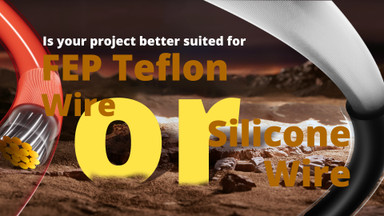Posted by BNTECHGO on 23rd Jul 2024
Is your project better suited for FEP Teflon wire or silicone wire?
In modern industrial and technological fields, choosing the right wire material is crucial for the performance and safety of equipment. Whether in high-temperature environments, highly corrosive locations, or applications requiring long-term stability, the choice of wire material directly impacts the success of the project. In this blog post, we will compare FEP Teflon wire and silicone wire in detail to help you decide which type of wire is more suitable for your project's needs.
When choosing the right wire material, it's important to consider multiple factors to ensure the wire meets the specific needs and environmental conditions of the project. Here are some key factors and their detailed explanations:
1.Choice of Temperature Resistance:
Although the temperature ratings of silicone wire and FEP Teflon wire are very similar (silicone wire ranges from -60°C to 200°C, and FEP Teflon wire from -65°C to 200°C), each has its strengths and weaknesses at different temperature ranges, primarily due to their material properties and application requirements.
- Advantages of FEP Teflon wire in high-temperature environments:
- Thermal Stability: FEP material performs excellently in high-temperature environments, with a melting point of 260°C, which is slightly higher than that of silicone. This means FEP wire can maintain its structural integrity and functionality even near its high-temperature limit, while silicone may degrade or deteriorate in performance at this temperature. The high melting point gives FEP wire an advantage in extreme high-temperature applications, allowing it to operate stably at temperatures of 200°C without degrading or failing.
- Flame Retardancy: Both FEP Teflon wire and silicone wire have self-extinguishing properties, ensuring they can quickly extinguish after the removal of a flame source, preventing the spread of fire. However, their flame retardant standards differ. FEP Teflon wire meets the FT1 standard, suitable for vertical wiring applications with high safety requirements, ensuring that the wire does not become a path for fire spread during a fire. Silicone wire meets the FT2 standard, suitable for horizontal wiring, with relatively lenient test conditions since the spread of flames horizontally is less extensive. Silicone wire provides moderate flame retardancy, suitable for use inside general electronic devices and appliances.
- Advantages of silicone wire in low-temperature environments:
- Although FEP Teflon wire is also stable in low temperatures, its flexibility and mechanical performance at extremely low temperatures are inferior to those of silicone wire. FEP material may become relatively hard at extremely low temperatures, increasing the risk of breakage. Silicone material remains elastic and soft even near its low-temperature limit of -60°C, resisting brittleness or fracture.
- This characteristic makes silicone wire more suitable for low-temperature applications requiring high flexibility and mechanical performance, especially in applications involving frequent movement and bending, where the flexibility of silicone wire ensures reliability at low temperatures. Additionally, silicone wire excels in specific industrial settings, such as low-temperature storage facilities and outdoor equipment.
2.Electrical Performance Choices:
- FEP Teflon wire: For high-frequency signal transmission and high-precision electronic devices, FEP Teflon wire is a better choice due to its low dielectric constant and dielectric loss, providing stable electrical insulation performance.
- Silicone wire: For general electrical applications, silicone wire provides reliable electrical insulation performance, suitable for a wide range of electrical systems.
3.Chemical Environment Choice:
- FEP Teflon wire excels in highly corrosive environments, able to resist corrosion from most chemicals, including strong acids, strong bases, solvents, and other chemical substances. This is because the molecular structure of FEP contains strong carbon-fluorine bonds, which are highly stable and strong, giving FEP material a high resistance to various chemical substances. Carbon-fluorine bonds are among the highest energy chemical bonds known, making them difficult to destroy by chemical substances. FEP material also has a very low surface energy, meaning that chemical substances are less likely to adhere to its surface, reducing erosion and degradation by chemicals, and enhancing its chemical resistance. The high electronegativity of fluorine atoms effectively resists oxidation and reduction reactions, allowing FEP material to maintain its performance in extreme chemical environments. The non-polar nature of FEP material makes it less likely to react with polar chemical substances, further enhancing its chemical corrosion resistance. Due to these chemical and physical properties, FEP Teflon wire exhibits excellent corrosion resistance in extreme chemical environments, making it suitable for various applications requiring high chemical stability.
- Silicone wire also has some chemical resistance, although it may not perform as well as FEP wire in extreme chemical environments. However, silicone wire is suitable for use in moderately corrosive environments, such as weak acids and weak bases (acetic acid, citric acid, sodium carbonate, ammonium hydroxide, etc.), low concentrations of strong acids and strong bases (hydrochloric acid, sulfuric acid, nitric acid, sodium hydroxide, etc.), mild organic solvents (ethanol, acetone, methanol, etc.), neutral salt solutions (sodium chloride solution, sodium sulfate solution, etc.), and atmospheric corrosion (acid rain, industrial pollutants, marine environment salt spray, etc.). In these environments, silicone wire can provide sufficient chemical resistance and mechanical performance, ensuring its long-term performance and stability.
4.Safety and Environmental Choice:
- If the project has higher requirements for environmental friendliness and low toxicity of materials, silicone wire, due to its heavy metal-free and low-smoke, halogen-free characteristics, meets environmental requirements, especially in applications that need to protect the environment and human health. Choosing silicone wire over FEP Teflon wire, especially when the project has higher requirements for environmental friendliness and low toxicity of materials, has several reasons:
- Heavy Metal Free: Silicone wire does not contain heavy metals such as lead and cadmium, which pose potential hazards to the environment and human health. The heavy metal-free characteristic of silicone material makes it more environmentally friendly and safe, especially suitable for use in applications with strict environmental material requirements.
- Low Smoke, Halogen Free: Silicone wire does not produce toxic halogenated gases, such as dioxins and hydrogen fluoride, when burning. Traditional halogenated materials produce toxic gases and smoke when burning, while the low-smoke, halogen-free characteristic of silicone material reduces secondary pollution during fires, thereby increasing safety.
- Biocompatibility: Silicone material has excellent biocompatibility, being non-toxic and harmless to the human body. This makes silicone wire very suitable for medical equipment, food processing, and other applications requiring direct contact with the human body.
- Biodegradability and Recyclability: Although silicone itself is not biodegradable, its recycling and processing are relatively simple. Silicone waste can be reprocessed through specific processes, reducing environmental impact. Additionally, silicone material can degrade under appropriate conditions without causing long-term pollution to the environment.
- Eco-Friendly Manufacturing Process: The manufacturing process of silicone material is relatively environmentally friendly. Silicone is made from silicon dioxide, the main component in sand, which is abundantly available on Earth. Its manufacturing process does not involve harmful chemicals, thus reducing environmental pollution.
- Stability and Durability: Silicone material exhibits excellent stability and durability under various environmental conditions. This reduces the need for frequent material replacements, thereby decreasing resource waste and waste generation, further highlighting its environmental advantages.
So, in specific scenarios such as high-temperature environments, high-frequency signal transmission, highly corrosive environments, low friction, and anti-adhesion characteristics, it is more appropriate to choose FEP Teflon wire. For applications needing to meet environmental standards, low-temperature environments, moderate corrosive environments, maintaining high flexibility, and frequent bending operations, silicone wire is more appropriate.
FEP Teflon wire and silicone wire each have unique advantages, making them suitable for different application scenarios. Based on a comprehensive assessment of the specific needs and environmental conditions of the project, choose the most suitable wire material to ensure it can provide reliable performance and safety, thereby enhancing the overall reliability and efficiency of the equipment.
We hope this blog post has helped you better understand the characteristics of FEP Teflon wire and silicone wire, enabling you to make the most suitable choice for your project. If you have any questions or need further support, please feel free to contact our technical team. We are committed to providing the best solutions to help you achieve project success. For more information about our products and services, please email us at support@bntechgo.com, visit our website at https://bntechgo.com, or follow us on YouTube, Facebook, TikTok, LinkedIn, and Instagram. We look forward to connecting with you.
For article reprints, please cite the source.







